Have you ever stared at a stubborn tree stump in your yard and thought, Why can’t I just burn this thing and be done with it? It’s frustrating when you just want a clean, easy solution, only to find out that lighting it on fire might land you in trouble. Between local laws, fire hazards, and environmental concerns, what seems simple can suddenly feel complicated and risky.
In this blog, we’ll break down exactly why is stump burning illegal and what it means for homeowners like you. You’ll get a clear understanding of the legal, environmental, and safety reasons behind the restrictions, plus practical alternatives for removing that pesky stump safely and effectively. By the end, you’ll know exactly how to handle your tree stumps without breaking any rules or putting yourself at risk.
10 Rules About Burning Tree Stumps
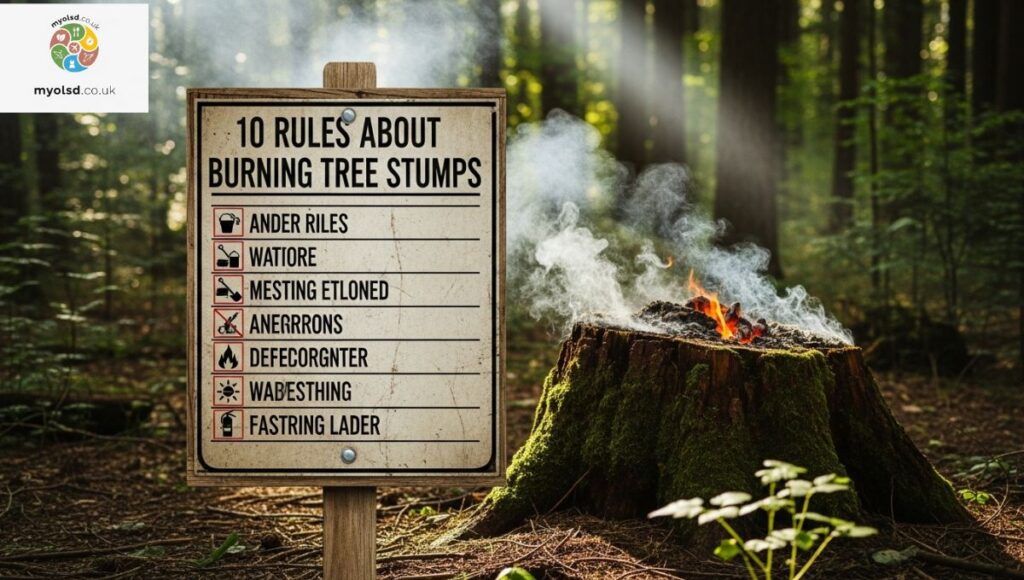
- Check Local Laws: Many municipalities ban stump burning outright. Always verify with your local fire department or city office.
- Permit Requirements: Some areas allow burning only if you have a permit. Not having one can lead to fines or legal action.
- Time Restrictions: Burns are often only allowed between sunrise and sunset. Nighttime burns are strictly prohibited.
- Supervision: Never leave a stump fire unattended. A few sparks can quickly turn into a dangerous wildfire.
- Fire Control: Keep a hose, water source, or fire extinguisher nearby at all times.
- Flammable Materials: Remove debris, leaves, or other flammable objects from the area before burning.
- Stump Size Limits: Some local laws restrict the size of stumps you can burn. Large stumps may require professional removal.
- Seasonal Restrictions: Dry seasons or windy conditions often trigger burn bans.
- Smoke Management: Burning stumps produce toxic smoke and airborne particles that can affect neighbors and air quality.
- Disposal of Ashes: Ashes must be safely disposed of to prevent soil contamination or fire hazards.
Why You Shouldn’t Burn Tree Stumps
Burning stumps may seem convenient, but it comes with serious risks. Fires can quickly spread to nearby structures, fences, or your own house. Smoke contains carbon monoxide, VOCs, and other toxins that can trigger respiratory issues or worsen existing conditions.
Beyond health concerns, stump burning destroys soil microorganisms and can destabilize your yard’s ecosystem. It’s a practice that harms the environment, contributes to air pollution, and increases your liability. That’s why so many experts and municipalities strictly forbid it.
Can I Have a Fire in My Backyard if I Have a Tree Stump?
Some homeowners assume backyard fires are harmless, but laws often differentiate between recreational fires and stump burning. While a small campfire may be allowed, lighting a tree stump without proper permits is illegal in most regions.
Even if regulations permit it, fire safety guidelines require strict supervision, protective gear, and fire control equipment. An uncontrolled stump fire can escalate into a wildfire within minutes, causing property damage and threatening lives.
Read more Article: Why Is My Dog Panting?
How Long Do I Have to Wait to Burn My Tree Stump?
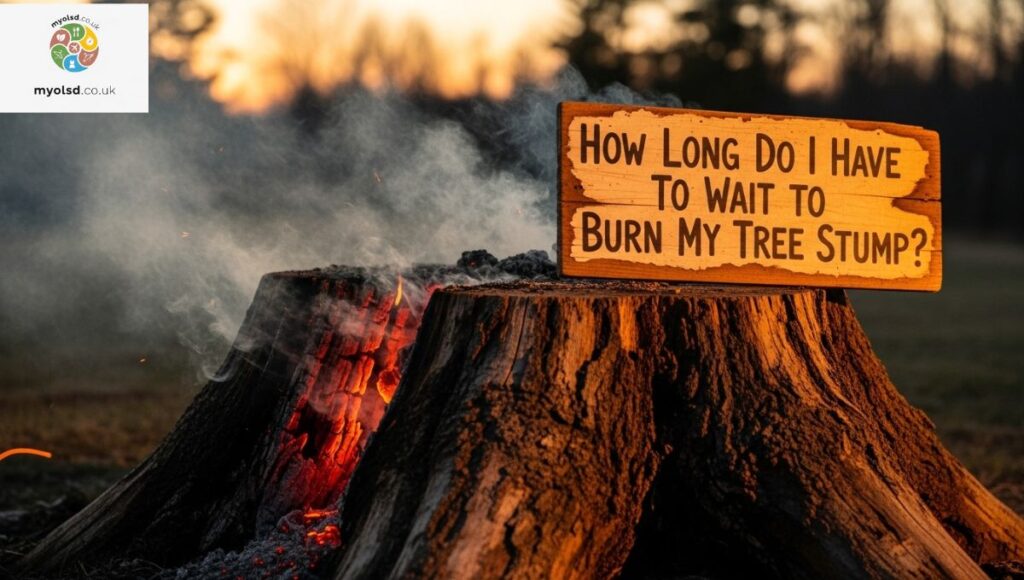
Waiting periods are typically mandated to allow the stump to dry and reduce smoke output. However, even dried stumps release harmful chemicals when burned. Regulations often recommend using alternative methods rather than waiting for a “safe” window to burn.
This waiting period also doesn’t eliminate fire hazards. Sparks can ignite nearby dry grass or debris, creating unpredictable risks. Responsible property owners often skip burning altogether for safer solutions.
Can I Legally Burn My Tree Stump?
In short, legality depends on your location. Some states and municipalities allow controlled burns with permits, while others prohibit it entirely. Violating fire regulations can result in fines, legal penalties, and even criminal charges.
Remember: even if allowed, improper stump burning is unsafe and environmentally damaging. Many homeowners are surprised to learn that safer alternatives exist and are often cheaper in the long run.
The Best Time of Year to Remove a Tree Stump
Instead of burning, consider removing stumps during dormant seasons. Late fall or early winter is ideal because the soil is firm, and trees aren’t actively growing. Seasonal timing also helps reduce the risk of insect infestations and diseases.
For professional removal, the timing can minimize damage to surrounding plants and lawn areas. Controlled methods like grinding or chemical decomposition work best when applied during the right season.
Can I Burn My Tree Stump if It Is Less Than 10 Feet Tall?
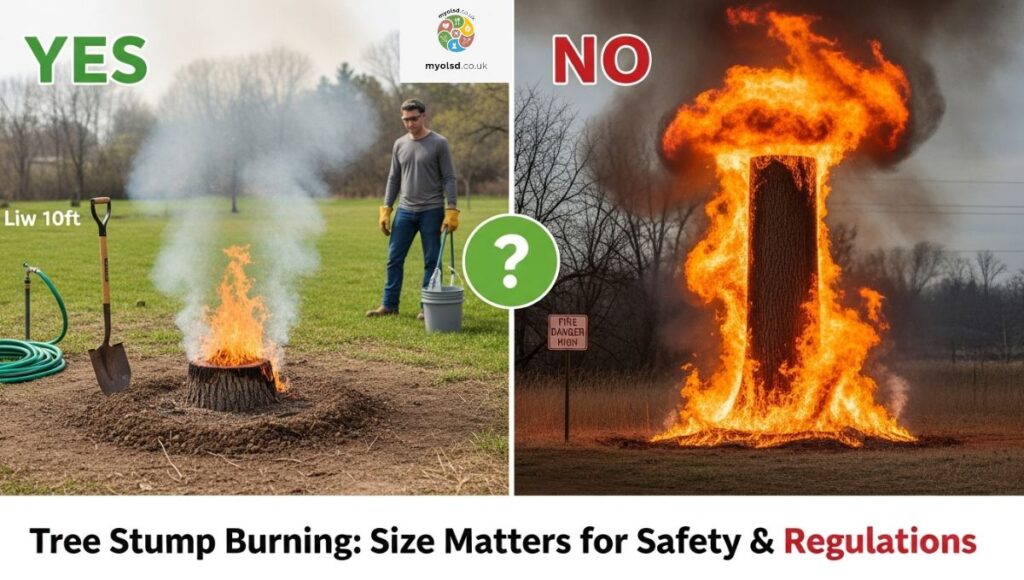
Even small stumps pose risks. A 10-foot or smaller stump may seem safe to burn, but it still produces toxic smoke and sparks that can spread. Fire spread prevention measures are required, and most municipalities regulate this regardless of size.
If local laws allow burning, ensure you follow all fire control strategies and safety equipment requirements. Often, mechanical removal or chemical treatment is safer and more reliable.
How Many Tree Stumps Can I Burn in My Front Yard Without Getting a Permit?
In most areas, even one stump may require a permit. Fire codes and municipal ordinances limit the number of stumps you can burn to reduce wildfire risks and protect air quality.
Unpermitted burning can result in fines, legal action, and property damage liability. Responsible homeowners plan stump removal carefully and often rely on professional services.
Alternatives to Burning Tree Stumps
1. Grinding
A stump grinder quickly converts stumps into wood chips, which can be used as mulch. Grinding minimizes soil disturbance and is environmentally safe.
2. Chemical Removal
Applying a chemical solution accelerates decomposition. This method requires patience but avoids fire risks entirely.
3. Pulling
Mechanical stump pullers can remove smaller stumps. This method is labor-intensive but safe and effective.
4. Digging
Manual digging and grubbing work well for medium-sized stumps. Protect surrounding plants and wear protective gear.
5. Roto-tilling
Roto-tilling breaks down roots and decomposes stumps over time. It’s a sustainable method for garden areas.
The Illegality of Stump Burning
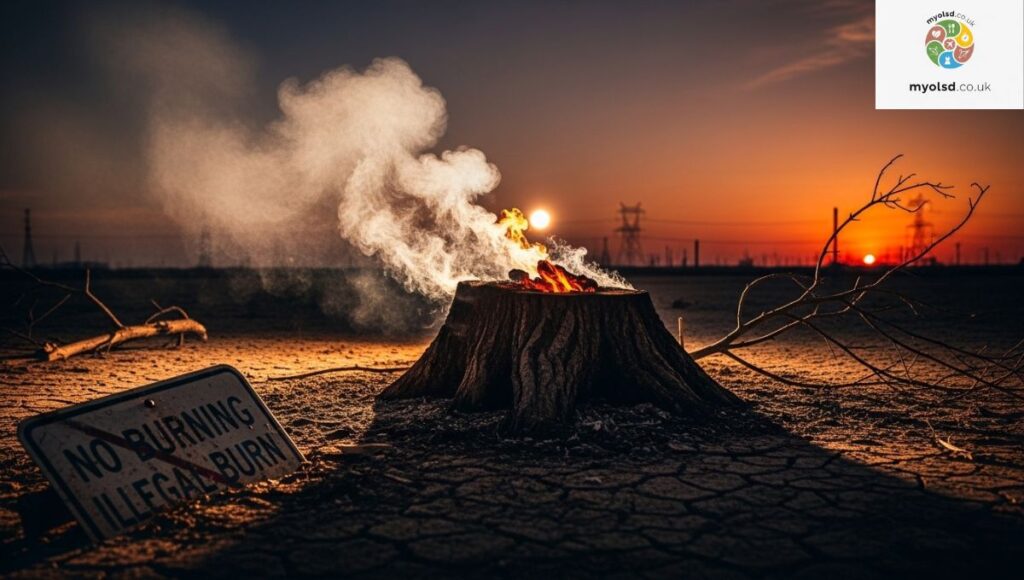
Stump burning is illegal in most states due to fire hazards, environmental damage, and public health risks. Municipal ordinances often prohibit burning without permits, and some regions enforce strict bans during dry seasons.
Fire department approval is usually required, and ignoring rules can result in fines or criminal charges. Safe removal options exist that comply with local authority regulations, making burning unnecessary.
Reasons for Stump Burning Bans
- Fire Hazard: Uncontrolled fires can cause wildfires.
- Environmental Hazard: Smoke contains toxins that harm air quality and climate.
- Health Hazard: Respiratory risks from inhaling smoke and particulate matter.
- Property Damage Risk: Sparks can damage nearby buildings or landscapes.
Environmental Impact of Stump Burning
Burning stumps releases greenhouse gases and destroys soil health. Beneficial microorganisms are killed, and ash can contaminate groundwater.
Alternative methods like grinding or chemical decomposition protect the environment while safely removing stumps. Sustainable removal prevents long-term damage to your yard and ecosystem.
Health and Safety Risks
Burning stumps exposes homeowners and neighbors to smoke inhalation, toxins, and risk of burns. Even a small fire can flare up unexpectedly.
Occupational safety measures, protective gear, and professional supervision are essential if you ever attempt controlled burns but avoiding burning entirely is always safer.
Safe and Legal Alternatives to Stump Burning
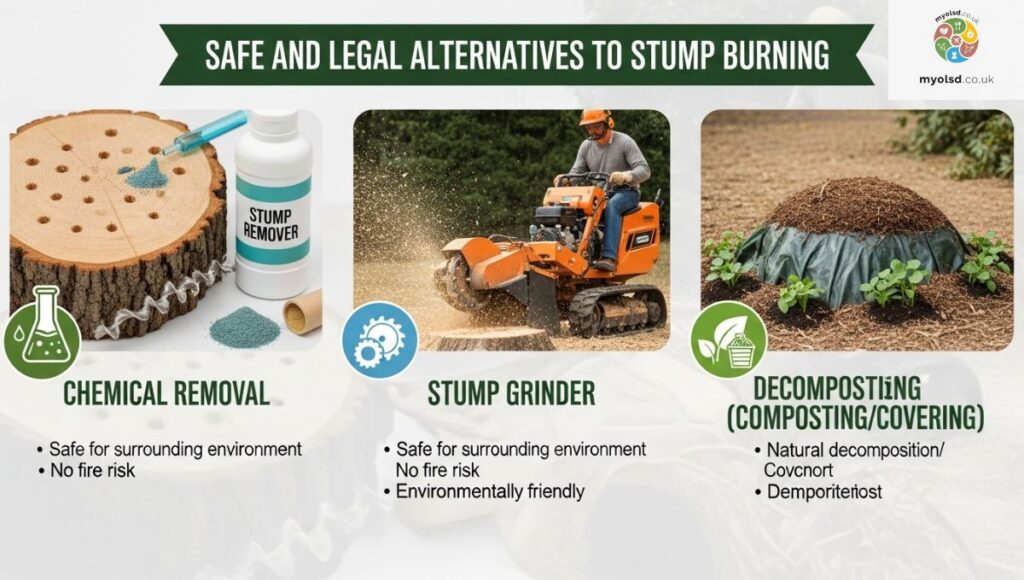
- Stump grinding
- Chemical stump removal
- Manual digging and pulling
- Roto-tilling
Professional removal services offer efficient, legal, and environmentally friendly options. These methods avoid fire risks, legal issues, and toxic smoke.
Professional Stump Removal Services
Hiring a certified arborist ensures safe, legal, and efficient stump removal. They bring equipment like stump grinders, roto-tillers, and chemical solutions while following municipal regulations.
Professional services also handle debris disposal, hazard prevention, and site cleanup. It’s the safest way to eliminate stumps without risking fines, injuries, or environmental damage.
Conclusion
Now you know why is stump burning illegal and the many reasons to avoid it from fire hazards and health risks to environmental damage and legal penalties. Safe alternatives like grinding, chemical treatment, pulling, or professional removal make it possible to eliminate stumps efficiently and responsibly.
By following regulations, using proper safety equipment, and considering eco-friendly methods, you can protect your property, your health, and the environment while keeping your yard clear of unwanted stumps.
FAQs
Why shouldn’t you burn a stump?
Burning a stump releases toxic smoke, damages soil, and poses serious fire risks. It’s illegal in many areas and can harm your health, property, and the environment.
Why is it so hard to burn a stump?
Stumps are dense, retain moisture, and have deep roots, making them difficult to ignite and sustain a fire. Even when dry, they burn slowly and unevenly.
What is the best fuel for burning stumps?
Hardwoods like oak or hickory burn hotter and longer than softwoods. However, burning any stump carries fire, smoke, and legal risks.
What kills tree stumps the fastest?
Chemical stump removers, grinding, or targeted herbicides are the fastest ways to kill a stump safely without fire.
How to get rid of a stump in 2 to 3 days naturally?
Using high-concentration chemical removers or a combination of drilling holes and applying salt can speed up natural decay, but complete removal usually takes longer.
How long does it take for a stump to decompose?
Natural decomposition can take 1 to 5 years depending on stump size, tree type, and environmental conditions.
What happens if you leave a stump in the ground?
Leftover stumps can sprout new shoots, attract insects, and cause decay that affects soil health and nearby plants.
What is the best time of year to remove a stump?
Late fall or early winter is ideal, as the tree is dormant, soil is firm, and insect or disease activity is lower.
Can Epsom salt remove a tree stump?
Epsom salt can help dry out a stump and speed decay slightly, but it is slow and works best combined with drilling or other removal methods.

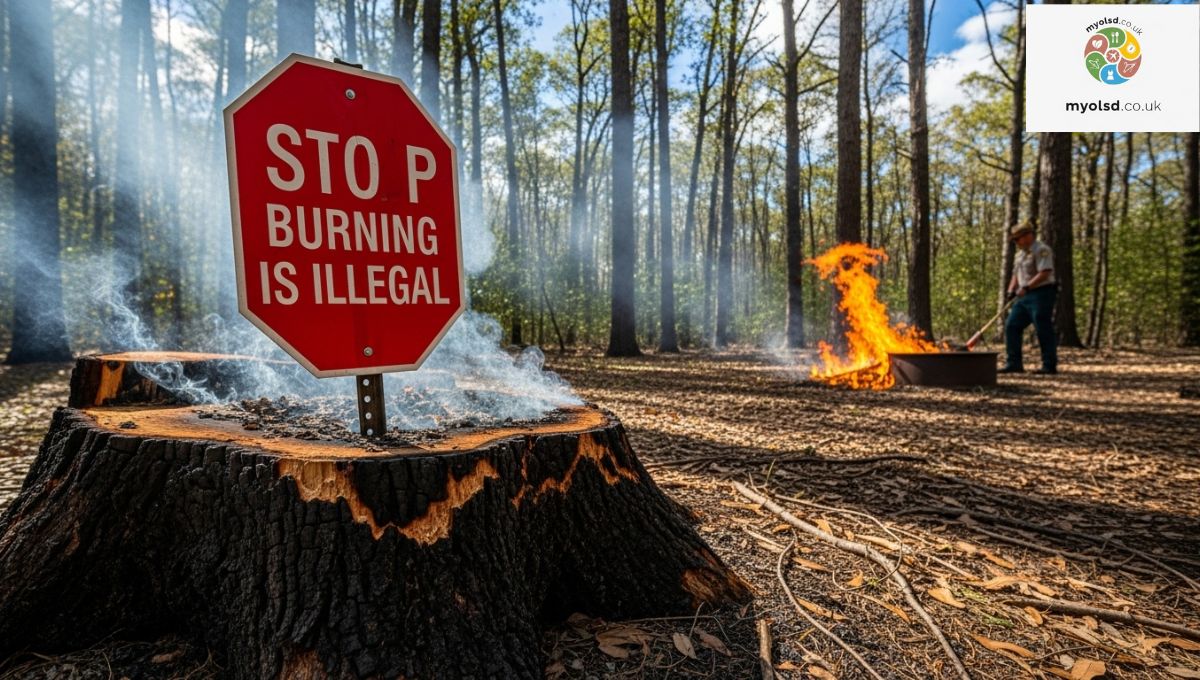
1 thought on “Why Stump Burning Is Illegal: Risks & Rules Explained”